 Leading Blog | Posts by Month |
 Leading Blog | Posts by Month |
03.31.09

LeadershipNow 140: March 2009 Compilation
Posted by Michael McKinney at 03:39 PM
03.30.09

Emotional Intelligence – How To Get ItCorporate psychologist Martyn Newman says that “being intelligent about your emotions is critical to your success as a leader. If leadership is ultimately the art of accomplishing extraordinary things through ordinary people, then building emotional capital is how you achieve it.”Competence will only get you so far. You need emotional intelligence to implement your ideas. In his book Emotional Capitalists, he writes that today’s leaders must focus on emotional capital. That is, “the energy, the enthusiasm and commitment in the hearts of everyone connected with the business.” The idea of emotional intelligence was popularized by Daniel Goleman and it is given form in this EI toolkit. Newman offers practical guidance to how it is developed and applied. He categorizes the emotional intelligence of effective leaders into five broad components: Self-awareness, Self-management, Social awareness, Social skills and Adaptability. These are skills that can be developed by anyone motivated to do so. There are ten competencies associated with these components, but there are seven that he has isolated that he has found to absolutely essential for leaders to focus on. They are: Self-Reliance: “Being self-reliant does not mean that you just go out and do your own thing. It means being secure enough in yourself to turn to others and take into account different points of view while regarding yourself as finally responsible for working out what has to be said or done.” Assertiveness: It’s not about being aggressive or passive but it’s about “being able to communicate your message honestly and directly, while respecting the fact that others may hold a different opinion or expectation.” It requires clear communications and self-control. Optimism: “Individuals and organizations who view their setbacks in the context of progress are much more likely to continue in their efforts towards success.” Self-Actualization: This is the power behind sustained high performance. Passion. “Passion is an emotional competency you can develop by focusing your attention on your discontent – what you are unhappy with or what you’d like to do better – and then cultivating a vision of how things could be different.” Self-Confidence: “Solid self-confidence is important because it is the platform that supports your ability to respond actively and positively to value-creating opportunities.” Building self-confidence is the starting point for unlocking the potential of yourself and others. Relationship Skills: “Why would you want to perform at your best when you don’t feel leadership is genuinely interested in you as a person?” Empathy: It is about “demonstrating that you can see the world from another person’s point of view.” Newman shows how you can develop each of these competencies and how you can deal with some of the toxic behaviors and thinking that you may have acquired over the years. It is a very helpful book that also offers readers an opportunity to take the Emotional Capital Inventory to measure your personal level of emotional capital. Check it out! While we are on the topic, Jossey-Bass released in paperback two essential volumes on social skills and common sense: Social Intelligence: The New Science of Success and Practical Intelligence: The Art and Science of Common Sense. Management consultant Karl Albrecht deftly illuminates these topics with such great stories, examples and humor that you will find them not just a great read but you will quickly identify with the ideas he is presenting with your own experiences. The insights contained in these books are immediately applicable in your relationships on and off the playing field.
Posted by Michael McKinney at 11:30 PM
03.24.09

Newswire: The Myth of the Lone Star
Posted by Michael McKinney at 12:04 AM
03.23.09

MBA Arrogance and the Myth of Leadership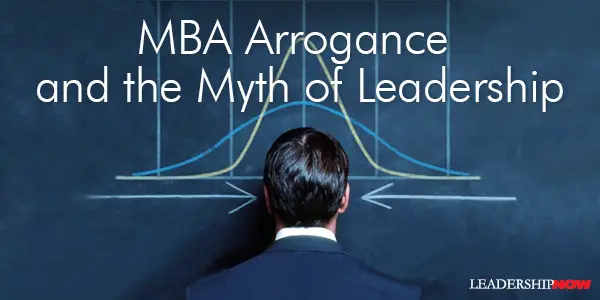
PHILIP Delves Broughton, author of Ahead of The Curve: Two Years at Harvard Business School, writes in the Financial Times about MBA Arrogance and the Myth of Leadership. Broughton observes: What business schools can teach is organisational behaviour. They can teach compensation systems and recruitment processes. They can offer classes on cash and non-cash incentives, on training, promotion and the value of a corporate culture. They can offer frameworks for negotiations, strategy decisions and implementing change. But when they bundle this up and call it leadership, they risk leaving their students with the faulty impression that they are now qualified, if not obliged, to go into the world and lead. It breeds the arrogance for which MBAs are mocked. It is the merit of Broughton to remind readers of the problems of surrounding leadership education. He is right. Business schools are best at teaching the competencies that business leaders need when performing their tasks. And at this point in time, they are probably rethinking what that means. Teaching leadership – as in take these classes and read these books and you are a leader – is something else. Broughton correctly asserts that MBA students often walk out into the world thinking that they are uniquely equipped to lead the world. It’s an arrogance that is rarely appreciated in the real world and an approach that does not serve them well in the long-term. Books and lectures do not make you a leader, but they can give you the tools to become a leader through the practice of leadership. They point you in the right direction. They fast-track your awareness. They are extremely valuable but they do not make you a leader. That label is earned, not taught. Broughton states, “Not all MBAs can be leaders, nor need they be. Every business needs followers: people who are good at what they do, who are able to implement the plans laid out by leaders.” Here is where discussions of leadership often derail. Broughton is confusing leadership with position. Position is the brass ring and there are a limited number of those to go around. Most people will be left out. He’s right. We can’t all have position, but we can all be leaders. Likewise, we are all – regardless of our position – followers. The idea that “I’m a leader, not a follower” is a foolish notion and belies the ignorance of what leadership really is by anyone who states it. Leadership is intentional influence. Basic to a proper understanding of leadership is the understanding that leadership is not position and does not make you a leader. There was a time when management was just management, the science of providing organizational support for innovators and salespeople to win customers and revenue. No, business schools need leadership courses. They just need better ones. They need courses with a proper emphasis about leadership. I appreciate his phrasing – “this super-sizing of management” – but management and leadership go together. They are often separated so that we can, by pulling them apart, see how they fit together. We need both and we need to be practicing both. One is not better than the other. A good leader manages. A good manager leads. 
Posted by Michael McKinney at 10:50 AM
03.19.09

The Bull Inside the Bear - Is You!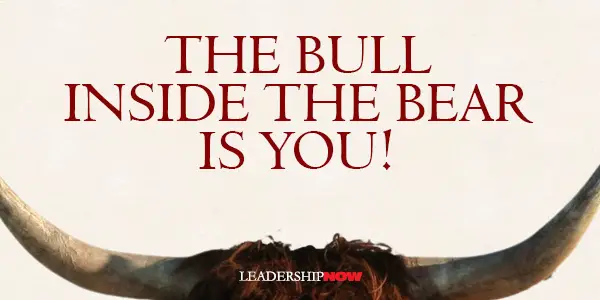 IF you’re looking for a candid explanation of the financial crisis and what you can do about it, you couldn’t go wrong with investment manager and former Federal Reserve economist Robert Stein’s book, The Bull Inside the Bear. He puts a perspective on recent events that paves the way for rational thinking. I found his review of the fundamentals of economics in the context of the financial crisis to be most helpful. Here are several excerpts:
IF you’re looking for a candid explanation of the financial crisis and what you can do about it, you couldn’t go wrong with investment manager and former Federal Reserve economist Robert Stein’s book, The Bull Inside the Bear. He puts a perspective on recent events that paves the way for rational thinking. I found his review of the fundamentals of economics in the context of the financial crisis to be most helpful. Here are several excerpts:
The subtitle, Finding New Investment Opportunities in Today’s Fast-Changing Financial Markets, is well met and should be reviewed by anyone considering where to go next. I’ll leave you with two more thoughts:  "The more educated and empowered you are, the better decisions you will make—not by listening to the talking heads on television or reading the latest blog posting. You will do your own homework and your own research, paying attention to the economic indicators that tell you what’s happening. This is not difficult, and it will put you in the driver’s eat as you make investment decisions based on better rationale than buy-hold-and-forget it or panicking and following the crowd." 
Posted by Michael McKinney at 05:20 PM
03.18.09

Collapse of Distinction: How Do You Get People Thinking About You?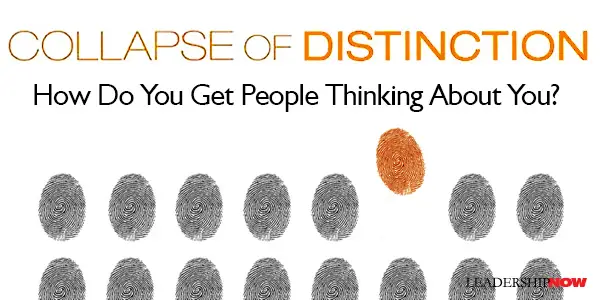
I'VE SEEN Scott McKain speak on a couple of occasions and he is all about customer experience in both content and delivery. His new book Collapse of Distinction, is no different. The collapse of distinction is a cultural phenomenon of not just blandness, but sameness. McKain writes that it has become a “corporate and professional nightmare.” The current economic environment makes this book all the more important. The problem isn’t just the economy though; it’s that the economy exposes a problem that is more easily ignored in a good economy. To ignore the collapse of distinction now, can be fatal. Today customers want value more than ever. How will you create that value? Low price isn’t the answer, but without doing the homework, that’s really all you’re left with. McKain writes, “If you cannot find it within yourself to become emotional, committed, engaged, and yes, fervent about differentiation, then you had better be prepared to take your place among that vast throng of the mediocre who are judged by their customers solely on the basis of price. It is the singularly worst place to be in all of business. If you aren't willing to create distinction for yourself in your profession—and for your organization in the marketplace—then prepare to take your seat in the back, with the substantial swarm of the similar, where tedium reigns supreme.” Three factors conspire to destroy differentiation:
Coming to grips with this propensity of human behavior takes a lot of effort. We would rather “execute the least progressive, most conforming activity [we] can to achieve the success [we] desire.” However, McKain lays out the process to overcome sameness to lift you or your company out of the doldrums, as clearly and as simply as possible. How do you grab attention? How do you get people thinking about you? How do you get the opportunity to use the combination of your expertise and talent? You can differentiate yourself on product, price, and/or service. For most of us, the only real way we are going to differentiate ourselves is through service. McKain lays out the Four Cornerstones of Distinction and devotes a chapter to each explaining how you apply them in your situation: Clarity, Creativity, Communication and Customer-Focus. Each chapter ends with an executive summary and solid action-points to get the ball rolling. He says that we have to profitably create experiences that are so compelling to our customers that loyalty is assured. Your organization's survival may depend on the concepts presented in this book. “What is compelling about you, what will create points of distinction about you, and what will establish a connection between us?” You do not need to change everything about how you do business to create distinction. Start by walking through your list of points of contact with customers, reframing and redefining how you perceive each moment of interaction. From these new perspectives, you can then begin to create specific points of differentiation with your customers. By developing your professional laundry list from the exercise—and recognizing that if these practices are the industry standard, then they will almost always fail to create distinction for you—you are taking an important first step in disciplining yourself as a professional to develop differentiated methods and tactics. Different is not just good, different is better. UPDATE: Collapse of Distinction has been updated and retitled: Create Distinction: What to Do When ''Great'' Isn't Good Enough to Grow Your Business (2013) 
Posted by Michael McKinney at 03:56 PM
03.17.09

What To Do When Growth Stalls
Steve McKee has written an insightful analysis of the problem. When Growth Stalls “is about generating growth for your company at a time when growth may be nothing but a glimmer of hope in your mind.” There are external forces that we all fall victim to: economic upheavals, aggressive competition, and changing industry dynamics. But McKee’s research has identified four internal factors that work against recovery and often paralyze you: Lack of Consensus. Consensus doesn’t mean management by committee. It means “agreement among an organization’s senior leadership about the nature and purpose of the company and where it’s intended to go.” McKee writes, “Consensus issues are hard to identify and unpleasant to face. But if you have a consensus problem, things can’t get better until you recognize it.” Only then can you work together to uncover the genuine issues you are facing. Everyone needs to be on the same page working from the same playbook. Loss of Focus. “No matter how big the company, its management team has only a finite amount of resources—money, time, talent, energy—at its disposal. The less focused those resources become, the less muscle management can muster to move the company forward or, if necessary, pull it out of a ditch.” Loss of Nerve. Probably the most insidious factor. When growth stalls, as McKee points out, it’s confusing. “Great leaders are supposed to be firm, decisive, and sure-footed. When things go wrong, you just fix them. That is until the problems spin beyond your control.” It’s discouraging. “When the road drops out from under the company, the CEO’s own discouragement can be difficult to hide.” It’s contagious. “It’s one thing to struggle privately…it’s quite another when the discouragement and disillusionment hit you so hard you can’t hide them. When the CEO is worried, everybody’s worried.” It's paralyzing. “You don’t have the luxury to think strategically when things are so desperate.” It’s wearying. As one CEO told him, “I wasn’t so much scared as ticked off and drained. I was tired of pushing the rock up the mountain like Sisyphus.”
Marketing Inconsistency. “The companies with the strongest track records do everything they can to maintain a consistent identity in the marketplace, even as the economy moves up and down, competitors come and go, and consumer tastes shift.” These four factors can create a vicious cycle that can be crippling. The first step is to step back and understand that while it is common as a leader to feel guilt, “that attitude is not only unhealthy and unproductive, in most cases, it’s just plain incorrect….As long as denial, doubt, and fear—and in some cases, sniping, finger-pointing, and other destructive behaviors—are wreaking havoc with your internal dynamics, you’ll remain stuck in the vicious cycle.” McKee shows you how to identify and deal productively with these factors. Writing from personal experience, he uses good examples and appropriate metaphors to explain what is happening when growth stalls. This adds to the book’s credibility and the friendly, thoughtful tone of his writing. If your growth has stalled, you need this book to help you get your company back on track. 
Posted by Michael McKinney at 12:00 AM
03.16.09

Stimulus Package 2 - Free Book: Greater Than Yourself Here’s a stimulus package to get you thinking. It’s a package designed to serve as a catalyst to help you to find ways to make things work and get things done. While you might think of it as a piece of good fortune, don’t think of it as a bailout. You’ve still got to do the inside work. Here’s a stimulus package to get you thinking. It’s a package designed to serve as a catalyst to help you to find ways to make things work and get things done. While you might think of it as a piece of good fortune, don’t think of it as a bailout. You’ve still got to do the inside work.
We are giving away five copies of Greater Than Yourself by Steve Farber. Greater Than Yourself is based on the premise that great leaders become great because they cause others to be greater than they are. GTY is a one-on-one development process where you choose to help someone become more capable, competent, and accomplished than you are. For a chance to get a copy, leave a comment on this post telling us who you have selected for your Greater Than Yourself project and we will randomly select five recipients on Monday, March 23, 2009. The opportunity to participate in this Stimulus Package will close on Friday, March 20, 2009. Related Interest: UPDATE: Five respondents have been chosen at random. Thanks for participating.
Posted by Michael McKinney at 07:44 PM
03.14.09

ReQuotes: "You're gonna like the way they sound. I guarantee it!" In an issue of Direct magazine, you will find legendary copywriter Herschell Gordon Lewis in his usual good form. In his Curmudgeon at Large column he ponders “how successful certain events would have been if the principals had been shrewd and savvy enough to pick up some of our advertising and marketing talk.” Here are several outtakes:
Posted by Michael McKinney at 11:04 AM
03.13.09

Newswire: The Cult of Shareholder Value
Posted by Michael McKinney at 09:56 AM

Shrink to Grow and Other Backward Steps ForwardIn The Moneymakers (i.e., long term winners – consistent performers), author Anne-Marie Fink addresses foundational business issues from her experience as one charged with understanding whether businesses were solid, long-term moneymakers – or rotten tomatoes – before investing with them. Fink has spent more than twelve years studying businesses and investments, as a vice president and analyst at JPMorgan Asset and Wealth Management.Not all of the concepts are new – is there such a thing? – but they are all important, well thought out and presented in a way that will make you stop and reconsider your approach. These concepts are divided up into eleven lessons that she has formulated from observing real-world businesses that work. The eleven lessons are:
Even for the moneymakers, eventually something goes wrong. What distinguishes them is how the handle it. A downturn is an opportunity to step back in order to move forward. She calls it shrink to grow. Here are ways she suggests to make the most of a downturn in business: • Fess Up Don't massage your numbers. You will only postpone the day of reckoning and make things worse when that day arrives. Don't let the short-term pain of admitting to disappointing numbers determine your execution and your spending. Good managers and partners will stand. If you have a good strategy and execution, earnings will come back and your stock price with it. • Fish or Cut Bait Don’t let hubris, fear of admitting a mistake, or concern about walking away from a prior investment keep you from exiting a problematic business. Consider the value of your time when considering whether to exit a business. [And I thought this was key:] Exit underperforming operations even if it means opting out of a potentially lucrative long-term trend. The trend may not be “ripe.” By getting gout of the business now, you will be able to retrench and come back later. Look for alternative ways to participate in the trend rather than stubbornly sticking with a losing proposition. • Shrink to Grow Shrink troubled operations down to their profitable core; if there is no profitable core, either sell or close the operations. Err on the side of cutting too much rather than too late. • Amputation or Minor Surgery Assess whether a slowdown is cyclical or long term, temporary or permanent, and calibrate your response accordingly. Even as you make cuts to respond to a slowdown, continue to invest to drive growth when the cyclical slowdown ends. Improve the mix of your business. She adds, “Exceptional leaders take steps backward in troubled times so they can lay a solid foundation for future growth.” Ask: Are the changes that are causing your operations difficulty rooted in long-term trends or cyclical events, or even a combination of both factors? Have you considered a “shrink to grow” strategy? When deciding where to invest during a difficult time, what are the goals of the spending? Will it produce a more efficient way to conduct your business? If so, then spend. Does it provide the next leg of growth when the market returns? If yes, then invest – but somewhat more cautiously, since you do not know when the market will return. Does the investment produce better returns but only at volume levels above currently depressed levels? If so, then perhaps tinker around with the idea, but do not invest serious funds to it. In times like these, this book is certainly a place to spend some time.
Posted by Michael McKinney at 01:10 AM
03.11.09

Six Ways Companies Mismanage Risk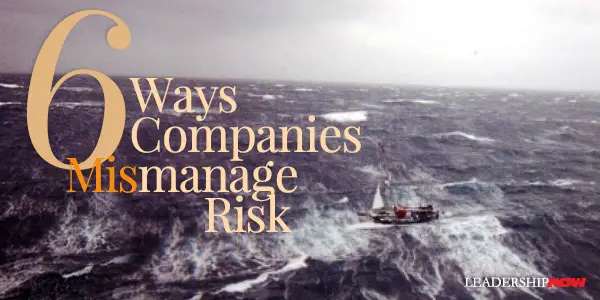
OHIO STATE University professor René Stulz writes in the Harvard Business Review, “Of course, financial institutions can suffer spectacular losses even when their risk management is first-rate. They are, after all, in the business of taking risks. When risk management does fail, however, it is in one of six basic ways, nearly all of them exemplified in the current crisis. Sometimes the problem lies with the data or measures that risk managers rely on. Sometimes it relates to how they identify and communicate the risks a company is exposed to. Financial risk management is hard to get right in the best of times.” Obviously, risk assessment needs to be tempered with time-tested experience and calculated risks need to cast a wider net when calculated. In summary, here are his six paths to failure:
Posted by Michael McKinney at 12:07 AM
03.09.09

Strategic Presence: The Power that Fuels LeadershipTony Jeary, author of Strategic Acceleration: Succeed at the Speed of Life, is a coach to some of the world's top CEOs. In his book he brings together practical ideas to help you get out of your own way. A critical aspect of getting things done through others is presence – your presence. To influence others you need to know how they perceive you and adjust your communication with them accordingly. Here, Tony discusses what he calls strategic presence:The goal of leadership is to produce superior results on purpose and that makes leadership a results contest. The challenge of leadership is to persuade and motivate those they lead to produce the results they want. When people voluntarily and enthusiastically do what their leaders ask them to do and the desired results are achieved, leaders are considered to be effective and successful! The question is how do leaders really get others to voluntarily and enthusiastically produce the desired results? There are many parts to this puzzle, but there is none greater than a condition I describe as Strategic Presence. Here is a great story that illustrates Strategic Presence and also illuminates its effect. A student from a foreign country was enrolled in the middle of a school year. During the first day of class, the other kids in the class were doing what kids do. There was a lot of giggling and staring and posturing for the new arrival. The new student was dressed in a way that did not meet the expectations of a few of the other children and eventually one of them (the class clown) began to make jokes about the new student's appearance. As the scene was progressing toward chaos, the teacher was about to intervene when a girl stood up and told everyone to stop picking on their new classmate. The girl reminded them that it was scary to be new in a school and they needed to be kind to the student and make them feel welcome She reminded them they should treat this new person as they would want to be treated if they were in a new country and a new school. After class, the teacher called the girl aside and said, "That was a very brave thing you did. Why did you do that?" The girl replied, "Because that is what my Mom and Dad would expect me to do!" This story powerfully illustrates the essence and the effect of what I call Strategic Presence. The girl had merely done what she knew her parents would want her to do. Her parents had succeeded in creating a positive presence in her mind, which gave her the willingness and courage to do what she did. Most importantly, the presence of her parents was so authentic that they did not have to be physically present to inspire their daughter's good behavior. Leaders create impressions that exist in the mind of every person they lead. It is a presence that defines the perceptions people have of their leaders and what they believe about them. It is this overall persona that I am referring to when I use the term Strategic Presence and there are two types: Positive and Negative. Leaders are constantly creating and presenting images of influence that produce both. The most important fact about Strategic Presence is that it produces two possible reactions in others. It either produces voluntary cooperation or it produces various forms of resistance. If leaders generate positive Strategic Presence, people will be more likely to support what they want, most of the time. However, if perceptions of leadership are negative people will substitute resistance for cooperation. The possibilities of how people will respond to Strategic Presence are limited to cooperation or resistance. There is not much middle ground between them. As someone once said, "you are either for us against us!" It is easy to see why creating an authentic, positive strategic presence is critical for the execution of a vision. Creating positive Strategic Presence is not a strategy of manipulation. The positive strategic presence leaders project must be authentic. Failing the test of authenticity means the very image leadership hopes to establish will be perceived as deceptive and disingenuous, or worse. People are very perceptive and they will see through efforts to project a phony persona for the purposes of manipulating their behavior. So, why shouldn't a leader's strategic presence just be allowed to be what it is?" That is a great question and the answer is simple. Many leaders are misunderstood and create perceptions that really don't match their intent. So, understanding how Strategic Presence is created will minimize the possibility of being misunderstood. So, how is strategic presence is created? What are the things about leadership that speaks the loudest about it? What creates the perceptions that combine to produce Strategic Presence? There are two components that contribute to strategic presence: values and behavior. Our values are established by what we believe to be right, wrong, true, false, acceptable, unacceptable, appropriate and inappropriate. Let's face it, we have all developed deep, strong opinions about many things as we live our lives. Our opinions spring forth from your values and your values influence what we actually do. Our values and beliefs impact 5 categories of that drive our behavior, and it is our behavior that creates Strategic Presence. The five categories that drive behavior are:
Posted by Michael McKinney at 05:54 PM
03.06.09

7 Vital Behaviors of Effective Problem-Finders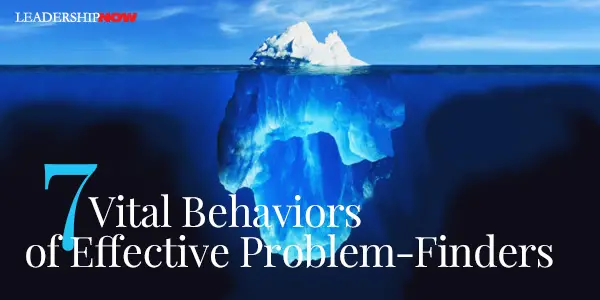
IN Know What You Don’t Know, Michael Roberto has identified the key skills and capabilities required to ensure that problems do not remain hidden in your organization. Keep in mind that problem-finding does not precede the processes of continuous improvement. Learning does not follow a linear path. Take the athlete who practices her sport on a regular basis. She does not always discover a problem first and then practice a new technique for overcoming that flaw. Sometimes, an athlete sets out on a normal practice routine, and through that process, she discovers problems that diminish her effectiveness. In sum, the processes of problem-finding and continuous improvement are inextricably linked. A person should not focus on one at the expense of the other, nor should he expect to proceed in a linear fashion from problem discovery to performance improvement. We often will discover new problems while working to solve old ones.
Adapted from Know What You Don't Know: How Great Leaders Prevent Problems Before They Happen by Michael A. Roberto 
Posted by Michael McKinney at 03:25 PM
03.04.09

Take the Greater Than Yourself ChallengeYou’ve heard “invest yourself in others” and “pay it forward.” Steve Farber has his own unique twist on these ideas and he calls it Greater Than Yourself.The Greater Than Yourself (GTY) concept is based on the premise that great leaders become great because they cause others to be greater than they are. GTY is a one-on-one development process where you choose to help someone become more capable, competent, and accomplished than you are. It has three parts to it: Expand Yourself, Give Yourself and Replicate Yourself. The life-long process begins with you. “You have to expand yourself before you can help make others greater.” That means that you have to make sure that everything that is you is constantly expanding. No matter how much you think you know or are, “you can always learn more, you can always experience more, you can always connect more and love more.” The point of which is to give it all away. Giving it all away always brings out the cynics. But Farber deals with that too. Giving it all away seems to imply subtraction – like a zero-sum-game – to many people. But it’s not. Giving it all away really adds to who you are. Parents get it, but when we get outside that relationship, an improper self-interest kicks in and we miss the bigger picture. In this business fable set along the California coast, Faber skillfully explains the true nature of giving it all away to become a creator of masters. GTY has life-changing possibilities if you commit to it. Expanding yourself “is a practice that should become part of your life. Integrate it into your thought process and into the way you make decisions. Will X add to your inventory? Will it expand an item that is already there? If so, do it; if not, don’t.” When you think of giving of yourself, money may not be part of it. You have other resources like “your talent, your knowledge, your connections, your confidence, your trust” and last but not least, “your time.” In the end, you want to replicate yourself. That is, you want to make sure that the people you elevate are doing the same for others. In an organizational context, it might look like this: “Everyone on my team and in our company should become significantly greater as a result of working with one another.” But, “I’m not trying to hire people who are more talented than me, I’m trying to hire people with heart, desire, drive, and mad potential, and then encourage all of them to bring out the best in one another by giving fully to one another. See the difference?” Farber admits that this isn’t easy to do initially. In response, he challenges us to pick just one person to make a GTY project. “Raise that person; boost him or her above yourself. Start there and see what happens.” He has created a web site with examples and resources to get you going. In particular, there is a four minute video of a GTY project conducted by the Up With People organization, that is a good overview of what this is all about and the impact it can have. The participants in this GTY project don’t rule out that great things can come in small packages. The tendency is to pick someone who is already doing well and then working to make them greater; jump on their bandwagon so to speak. There’s certainly nothing wrong in that, but perhaps the most impact can come from taking someone who really needs a leg up and connecting them to what they need. Take the Greater Than Yourself Challenge. Pick one person and give of yourself to make their life better—than yours!

Posted by Michael McKinney at 04:23 PM
03.02.09

First Look: Leadership Books for March 2009Here's a look at some of the best leadership books to be released in March.




For bulk orders call 1-800-423-8273
Posted by Michael McKinney at 01:28 AM
03.01.09

Protect Your Lunch with Anti-Theft Lunch Bags As more and more people brown bag it, this handy little item might be of interest. Tired of having your food stolen by sticky-fingered coworkers or roommates? Bullies taking your kid's lunch? Well, worry no more . . . Anti-Theft Lunch Bags are sandwich bags that have green splotches printed on both sides, making your freshly prepared lunch look spoiled. Don't suffer the injustice of having your sandwich stolen again! Protect your lunch with Anti-Theft Lunch Bags. These sandwich size (food-safe reusable and recyclable LDPE) bags may still be available from the designer the. (no that's it - "the.") the. is the official marketplace for amusing and eclectic wares designed by the. team. Mihoko Ouchi and Sherwood Forlee make up the. team. They have other interesting products they have designed on their web site. Have a look.
Posted by Michael McKinney at 08:28 AM
|
BUILD YOUR KNOWLEDGE


How to Do Your Start-Up Right STRAIGHT TALK FOR START-UPS 
Grow Your Leadership Skills NEW AND UPCOMING LEADERSHIP BOOKS 
Leadership Minute BITE-SIZE CONCEPTS YOU CAN CHEW ON 
Classic Leadership Books BOOKS TO READ BEFORE YOU LEAD |
|